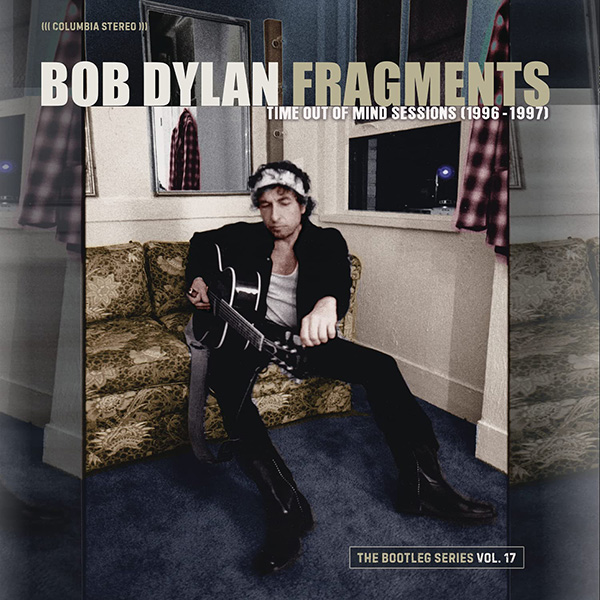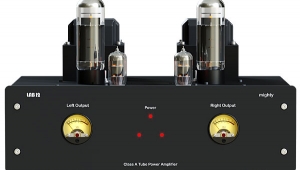| Columns Retired Columns & Blogs |
Gramophone Dreams #72: Abyss Diana & Focal Utopia headphones; Eleven Audio Broadway & Naim Uniti Atom HE amplifiers Page 2
The most exciting part of listening to this unusual album is how it slowly builds its own universe—inside the headphone listener's head—becoming more visual and emotionally associative with each track. Its progression of tracks and successions of tempos represent a musical promenade through the 16th to the 19th centuries in Spain, played on guitars that might have been used to play these works by the composers themselves. Played on guitars that had not been played in generations. When this album is reproduced in its full colorful pulsing vibrancy—like it was for me with the Diana TC—it goes beyond delirium and psychedelia in its effect. It's one thing to hear these guitarists play and quite another to experience the feeling behind their playing. The Diana TC preserved the nuance of these artists' most subtle dynamic shifts, letting me feel the musicians "feeling it" more and better than with the AB-1266 and every other headphone I can remember using. I put a high value on that.
In order to contextualize the above observations, I decided to see how this recording would sound with Eleven Audio's Broadway powering the $4000 open-back planar-magnetic Meze Elite headphones I reviewed in Gramophone Dreams #64.

On that same "Preludio: Asturias" track, the Elites made Díaz-Latorre's guitar playing sound bolder and more colorful and more elegant/beautiful—but farther away. The recording's space appeared deeper with the Elites, but the sound felt a few percentage points recessed through the presence region, with less perceived light and speed. Observing this made me wonder whether both Abyss 'phones emphasized music's presence region, or, alternatively, if the Meze flagship just slumped a touch between 1kHz and 4kHz.
On the 17th century Gaspar Sanz composition, "La Tarantella & Improvisación," the Diana TC lit up Xavier Díaz-Latorre's guitar, positioned stage front, and presented Pedro Estevan's drumming at the back of the stage with a crisp, spotlighted presence. With the Meze Elite, those backstage drum sounds were as clear and distinct as they were with the Diana, but they appeared smaller and more submerged in darkness.
This track provides a good illustration of how headphones image. With both headphones, Díaz-Latorre's guitar was bigger than my head and centered at the front of my skull. But the sound of Estevan's drumming was positioned completely outside my head, about an arm's length away to my right. After listening a while, my brain rendered those easily mappable spatial effects into a scene in a bare, shadowy David Lynchian room with me facing a spotlit guitarist and a drummer displayed in a narrower light about 10' behind. But here's the fascinating part: As one La Guitarra dels Lleons track led to the next, my brain enhanced this vivid, in-the-room picture to the point where my consciousness left that imaginary room and began carousing backstreet cafés in Barcelona. That was my reward for focused listening.
With the Diana TCs, that raw, sound-to-mind picture progression happened quickly and effortlessly. What more should I care about?
I divide headphones into three categories, by place of use: bike riding, subways, and flaneuring; home office, all day at the computer; and deep-night lights out. I use my HiFiMan RE2000 IEMs when I travel. I use my long-hours–comfortable Sony MDR-Z1 closed-backs at my desk. Now, JPS Labs' Diana TC and Eleven Audio's Broadway have become my first-choice late-night dreamscape generator. The Abyss Diana TC is the Abyss AB-1266 disguised as a pretty woman.

Focal's New Utopia + Naim Uniti Atom HE
When I reviewed Focal's glamorous-looking, serious-sounding Stellia closed-backs in GD #41, Wendy Knowles (head of PR for Focal Naim America) sent me Naim Audio's posh Uniti Atom HE DAC/amplifier/preamp (Headphone Edition). This helped a lot. With Focal-recommended electronics, I felt confident I was evaluating the Stellia not only in a manufacturer-approved manner but also in a way that it was likely to be used by potential customers.
For this report, Wendy upped her already fantastic game: She sent not only Naim's $3799 Uniti Atom HE amplifier but also Focal's previous, 2020 edition of the Utopia so I could compare it to the new—released in September 2022—version (footnote 4). Thank you, Wise Wendy.
I remember when it first came out, declaring the original Utopia more transparent to the source than my reference AKG K812 and more dynamic than my thumping "clear as outer space" Audeze LCD-2 (pre-Fazor), which I still regard as one of the greatest headphones ever. But that was 2016. Today there is a whole cadre of "greatest headphones ever."
Focal's new Utopia is only slightly changed from its forebear. The most obvious difference is a cosmetic upgrade involving less silver trim, more open-looking "honeycomb" inner and outer grilles, and a new lighter-weight, more stylish yoke made from "forged recycled carbon." The effect of these external changes is to make the new glossier-black Utopia look more luxurious—more like the "flagship" in Focal's line of exceptionally stylish headphones.
According to Focal, the Utopia's new inner grilles are M-shaped, conforming to the shape of the M-shaped driver which, Focal's product specialist Chris Shaw told me in an email, "smooths out the higher frequencies and improves clarity in the midrange."
Best I can tell, the most important change is Utopia's new voice-coil, which Chris Shaw said is made of 30% copper "to improve reliability" and 70% aluminum, "to reduce weight." According to Chris, "This alloy provides a rejuvenated sound signature that lends even greater neutrality, with powerful bass and more mellow treble." He added, "Exclusive to Focal, the patented speaker drivers run with zero active or passive correction from 5Hz to over 50kHz." This, to me, is key, because the chief reason I enjoy headphones is that their direct connection to an amplifier lets me feel like there is less electrical and room-acoustics mishegaas between my ears and the recording.
I enjoy doing component comparisons, especially of upgrades to long-admired products like Focal's Utopia. For these comparisons, I used only one DAC: the dCS Bartók into the line-level input of the Focal-endorsed Naim Audio Uniti Atom Headphone Edition amplifier.

Comparing both versions of the Utopia, the first thing I listened for was to see whether the new voice-coil made any difference in dynamic linearity. A lighter moving mass should be less inclined to compress changes in volume, better exposing nuance-level dynamic shifts in voice, rhythm, and reverberation. Casting about for the right record, I decided that variations in these traits might be easy to spot while listening to Volume 17 of Dylan's latest Bootleg Series, Fragments—Time Out of Mind Sessions (1996–1997) (24/96 FLAC, Columbia/Qobuz), a 2022 remix of the original reverb- and effects-soaked Grammy-winning 1996 release produced by Daniel Lanois. This new 5-CD box set was created by mixing engineer Michael Brauer, who says he was trying to capture "something that had more of a feel of what was going on in the room, with less additional processing." Using the new Utopias, I listened first to the Time Out of Mind track I knew best, one that always holds my attention, provokes the strongest feelings, and sticks stubbornly in my head: "Tryin' to Get to Heaven."
I've been walking through the middle of nowhere
Trying to get to heaven before they close the door
It took only seconds to notice the new scrubbed-clean, less reverb-saturated air around Dylan's vocals. Through the 2022 Utopias, this fresher, more brightly lit remix felt like I was listening with Michael Brauer in his mastering studio. Crisp, clean, and studio monitor–like were the adjectives that jumped into my mind. My brain told me, "This is it. This is how this remastered recording actually sounds." I found the new, "unsaturated" Time Out of Mind a lot easier to grok than the original.
Then I played "Tryin' to Get to Heaven" through the "old" Utopias. The sound closed down more than I imagined it would (remember: sequence is everything). With the 2016 Utopias, the 2022 Time Out of Mind sounded more like Lanois's 1996 version: darker, thicker, and less three-dimensional. This reduction in clarity made the song feel like it was moving more slowly. These old-new Utopia differences seemed irrationally more dramatic and different in nature than I expected. To learn more, I tried the old Utopias on a fast-moving song called "Believing" off a 2001 album called Renegade Heaven by the Bang on a Can All-Stars (16/44.1 FLAC, Cantaloupe Music/Tidal). This album emits waves of delicious reverb while showcasing dramatic shifts in volume, tone, and texture.
"Believing" moves at a hectic, staccato pace. The 2020 Utopia tracked its movements extremely well, but the sound was vaguely dark and "compressed" microdynamics-wise.
When I returned to the new Utopia, both "Believing" and "Tryin' to Get to Heaven" were brighter, clearer, and more reverberant.
In contrast to box speakers, audiophile-grade headphones do not require multiple drivers or reactive crossovers and therefore can and usually do sound quite different with different cables. The cable on the new Utopia looks completely different than the one on the old Utopia, so I decided to audition the old Utopia with the cables that came with the 2022 Utopia. Using the dCS Bartók, I listened to Jacqui McShee singing "Let No Man Steal Your Thyme" off Pentangle's eponymous 1968 release (16/44.1 MQA, Transatlantic/ Tidal). This beautifully recorded tune sounded sweet and set instruments in an appealing acoustic space. With the old cables on the old Utopia, the recording sounded clearer and more intelligible than I remembered it sounding when I was 18 and had a huge crush on Jacqui. With the new cables, it opened up considerably, becoming brighter and more see-into. Space and reverb were more explicit. Jacqui was closer to her microphone.
Headphones for the ages
If I already owned 2020 Utopias, I would not sell them. But I might consider owning both, or experimenting with amps and cables. Compared to its predecessor, the 2022 Utopia exhibits a more complete transparency, a quicker, higher bounce, and a more assured way with momentum. Focal's Utopia is easy to drive, and its looks and sonics are competitive with today's best at any price.
A must-audition.
Footnote 4: Focal-JMlab, 108 rue de l'avenir, 42353 La Talaudière cedex, France. Tel: (33) 04-77-43-57-00. Web: focal.com/en. US distributor: Focal Naim America, 313 Rue Marion, Repentigny, Quebec QC J5Z 4N8, Canada. Tel: (800) 663-9352. Web: focal.com/us.
- Log in or register to post comments




































